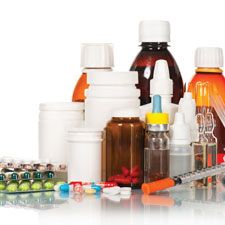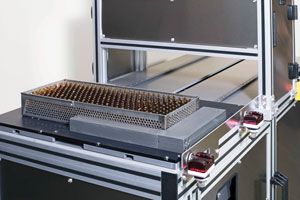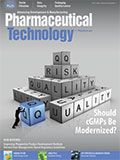Automating Quality Checks
Today’s inspection systems catch tinier flaws, manage data, and increasingly rely on artificial intelligence to further boost performance.
Alexandr Vasilyev - stock.adobe.com

For pharmaceutical manufacturers, product quality is a constant concern. Automating quality control offers several benefits, including reducing human error. Quality control systems help ensure consistent high quality, patient safety, regulatory compliance, and operational efficiency. Detection sensitivity is crucial. “Only if the system is able to detect even the smallest critical-to-safety quality defects will it be able to improve the production process,” says Michael Feldhaus, director of technology at SCHOTT Pharmaceutical Systems.
Quality control automation also simplifies regulatory compliance. “As increasingly complex serialization regulations take effect around the world, pharma product packaging must maintain the utmost quality while imparting critical information for all the trading partners in the pharma value chain-including the end consumer,” says Barb Brynstad, Pharma product marketing, Optel Group.
Oliver Stauffer, chief executive officer at PTI-Packaging Technologies & Inspection, agrees that regulatory requirements are driving many installations. He reports, “United States Pharmacopeia (USP)1207 and Annex 1 have shifted the guidance for container closure integrity. Both documents highlight different needs and have varying angles of interpretation. Appeasing the EMA [European Medicines Agency] and FDA requirements harmoniously is a current challenge many sites are navigating. Shifting inspection requirements to more reliable technologies for new drug submissions raises concerns over implications of retroactive liability for legacy products in similar container formats.”
He believes the answer is the adoption of non-destructive deterministic test methods with higher throughput and data traceability. The resulting data empowerspharmaceutical manufacturers and allow them to improve product quality and operations.
Whatever the reason for installing or upgrading quality control equipment, flexibility is imperative to handle the myriad of labels, cartons, trays, devices, and cases while maximizing line accuracy, minimizing downtime, and reducing costs related to recalls or incorrect or misleading labeling. As a result, strong demand continues for automated seal integrity testing (leak detection), checkweighing, contaminant detection, and product/package inspection.
Seal integrity
Seal integrity is crucial. A good seal ensures “product efficacy, shelf-life stability, and microbial sterility,” says Jeff Morrow-Lucas, director of Engineering at Leak Detection Associates. Non-destructive leak detection technologies include vacuum decay, airborne ultrasound, helium trace, high voltage, and laser-based headspace analysis. Selecting the right technology depends on the product, package, and sensitivity requirements. Morrow-Lucas notes it’s important to understand what the equipment is protecting against and advises verifying that desired pass/fail limits can be delivered by the model chosen. He also recommends selecting flexible equipment that works across today’s and tomorrow’s packaging formats.
Recent equipment innovations in seal integrity testing include PTI’s updated VeriPac tester, a vacuum-based unit that combines the ability to locate smaller leaks and shorten test cycle time with several in-demand features, such as non-subjective results, qualitative data analytics, and data trending. FLEX test chambers accommodate multiple flexible package sizes (1).
Another recent introduction from PTI, the semi-automatic Seal-Scan airborne ultrasound tester, delivers an in-depth profile of seal quality and works with any material combination regardless of color, transparency, print, surface finish, or porosity (2). For online applications, the Seal-Sensor airborne ultrasound tester identifies seal defects in less than one second and locates flaws that a human inspector cannot see. The unit passes or fails each pouch and also captures quantitative, traceable data (3).
Lighthouse Instruments supplies laser-based headspace analysis technology for the KHS Series inspection system from Bosch. It performs 100% container/closure integrity (CCI) inspection on vials, cartridges, and ampules and detects leaks by identifying changes in headspace gas composition or total headspace pressure. The company also offers FMS benchtop test systems as well as the Pulsar Headspace CCI Inspection Lease System for online applications (4).
CMP PHARM.MA combines high-voltage leak detection with visual inspection and labeling in its RS1-LAB/RS2-LAB machines, capable of handling 200 or 400 ampules, vials, or cartridges/min, respectively. Machines are equipped with four leak-test stations and a rotation system to support 360-degree surface inspection. Systems check for particles, correct fill level, leaks, and other flaws (5).
Although X-ray inspection typically checks for product contaminants, the Integrity-Check tools built into the Safeline X34 system from Mettler Toledo can identify products trapped in the seal of a blister pack or other format (6). “Historically, vision systems were utilized to perform this inspection,” says Sarrina Crowley, marketing communications manager at Mettler Toledo, North America, Product Inspection. However opaque packaging can be challenging for vision technology. Because opacity doesn’t affect X-ray performance, it “can detect product in seals in most scenarios,” she reports.
For induction seals on containers, cooled thermal imaging technology can check seal quality through the closed cap. The Countec Coglix InspecSeal TI-200 machine, represented in North America by Key International, inspects for damaged, inverted, incomplete, or missing seals; over- or under-heating; and loose or crooked caps and generates real-time data and statistics. The system is compatible with glass or high-density polyethylene (HDPE) containers from 20–200 mm in diameter and 50–300 mm in height and HDPE, polypropylene, or child-resistant caps (7).
Checkweighing
Checkweighing equipment also offers higher sensitivity levels and data collection and management capabilities. New systems offer the accuracy needed for combination filling or specialized filling of capsules. Richard Stedman, CEO at ACG Engineering, explains: “Many customers are now requiring net weight technology where individual dosing weight can be checked in the capsule. In addition to improved quality control, this [technology] provides more accurate data for compliance with stringent market requirements and evolving FDA guidelines. In instances of multiple-product doses (two or more products in one capsule), individual formulation weighing is becoming more crucial. … Such systems are set up for pre-fill weighing rather than post-fill and exemplify the next-generation solutions that pharma companies are seeking when upgrading from legacy gross-weight technology.” Current models from ACG Engineering feature a format-free design to handle any product, regardless of capsule size; sensitive and accurate load cells; and seamless integration with the capsule filling machine to reduce downtime or waiting.
Mettler Toledo’s portfolio of quality control equipment includes the updated Starweigh rotary stepper checkweigher. It features an improved human-machine interface (HMI), load cells, motor, and reject bins and handles small bottles and vials at +/- 2-mg accuracy. A dual load cell configuration operates at 120 containers/min. A duplex unit with four load cells doubles output. An outfeed with two rejects segregates over- and underweight containers.
The new Selekta checkweigher from MG America relies on capacitance technology from the company’s capsule fillers to check up to 160,000 tablets or capsules/hour. Models can be equipped to weigh and sort, weigh and count, or just count round tablets up to 10 mm in diameter, rectangular tablets up to 10 by 25 mm and capsules from size 000 to 5 (8).
Contaminant detection
For metal detection equipment, top-of-mind concerns include “stricter validation audits regarding metal detector testing, inspections, and calibrations as it relates to products and keeping electronic records,” reports Kris Tompkins, North America Pharmaceutical business and key accounts manager at Loma, which is celebrating its 50th anniversary this year. A comprehensive log book captures pertinent data from Loma metal detector, checkweighing, and X-ray inspection systems. Loma also provides TRACS remote data-management software to help companies meet record-keeping standards. Other pharma-friendly features found on Lomas’s IQ 4 metal detector include washdown compatibility; a larger, more user-friendly touch screen; and programmability so machine frequency can be matched to the product.
Machine vision
Machine vision inspection is more powerful than ever, as exemplified by camera-based systems from Acquire Automation, which simplify vial counting and check caps. The CountQ vision inspection system, shown in Figure 1, automates the counting of vials in trays, eliminating the need for counting manually or with a stencil as well as the duplicate counts generally required by standard operating procedures. The system consists of a linescan camera plus software, adjustable lights, and label printer. Advanced product counting tools enable it to adapt to targets with varying visual characteristics. Standard features include an easy-to-use HMI, report and audit logs, security levels that control access, two-touch changeover, and configurable run modes that increase the system’s flexibility (9).
Figure 1. Acquire Automation's CountQ vision inspection system counts vials in trays. Figure is courtesy of Acquire Automation.

The CapQ system from Acquire Automation performs a 360-degree inspection of caps up to 38 mm in diameter and 330 mm in height to check presence, color, height, and skew. It also confirms the integrity of the tamper-evident band and verifies fill level. The stainless steel, NEMA 4X/IP65 inspection unit fits over the conveyor, simplifying integration on existing packaging lines. Advanced software using artificial intelligence enables the system to ignore water droplets and plastic fragment shedding that can skew measurement results and cause false rejects. The system produces reports and audit data for production and inventory records and provides data for continuous improvement programs. Options include a height-adjustable main system enclosure, automatic camera and light adjustments during changeover, and a high-speed reject system (10).
For print inspection, Optel Group offers the HD PrintSafe digital inkjet with built-in 100% web inspection. The serialization-ready system checks artwork, alphanumerics, barcodes, and variable data and can grade print quality. Options include dual and multi-color printing, wide screen for large webs, and additional inspection capability for products inside blisters or trays (11).
Other serialization-ready equipment also integrates machine vision including the TQS Fast Track line from Wipotec OCS. The TQS-LI-Bottle machine, for example, prints, inspects, and labels bottles at a rate of 150/min. Changeover to a new size between 30 and 120 mm in diameter and 30 and 200 mm in height takes five minutes (12).
Machine vision also is used to ensure the quality of the package itself. “…Reducing packaging defects, such as cracks and bruises or even scratches in the glass, as well as particle generation is of high importance,” explains Christoph Döppes, project director New Production Concept Vials, Global Operations at SCHOTT Pharmaceutical Systems, which has partnered with SINCAD, a French engineering company and expert in modular vision control systems.
High-quality glass containers depend on high-quality glass tubing. Döppes reports, “As it is our aim to reach ‘zero defect’ in both tubing and pharma packaging, we moved from statistical quality control to 100% inspection of each FIOLAX tube during the production process. The process known as perfeXion leads to a glass tube that has been completely evaluated.” The Automated Inspection System (AIS) inspects all key surfaces of vials and cartridges and can detect defects invisible to the human eye. Advanced software creates a 3D image of the container based on visual data gathered from multiple cameras with different light settings. “We can therefore analyze the container surface in a more comprehensive way,” explains Feldhaus. Next-generation camera systems, equipped with artificial intelligence, will be able to learn from images of defective products and use that knowledge to independently recognize containers with defects.
Another packaging supplier, family-owned Colbert Packaging, which is celebrating its 60th anniversary in 2019, also has upgraded its quality assurance (QA) capabilities and now provides 100% vision inspection capabilities at all three of its manufacturing facilities. Its Leary Array with LearyVIEW Print QA system, recently installed at its Elkhart, IN plant, detects and rejects folding cartons with quality defects including missing copy, blemishes, streaks, oil spots, or other imperfections. “The new Leary QA system has a camera that scans the entire carton against the approved customer-supplied proof for visual quality defects,” said Nick Stober, Colbert’s Elkhart production manager. Eye C inspection software supports 100% inline inspection at speeds of 400 m/min (1300 ft/min) (13).
References
1. PTI-Package Technology & Inspection, “Transformative Shifts in Vacuum Decay Leak Testing,” Brochure, October 2018.
2. PTI-Package Technology & Inspection, “Seal Quality Testing and Seal Analysis,” Brochure, 2019.
3. PTI-Package Technology & Inspection, “Immediate Seal Check and Seal Verification,” Brochure, 2018.
4. Lighthouse Instruments, “Bosch KHS for CCI,” www.lighthouseinstruments.com, accessed May 28, 2019.
5. CMP PHARM.MA, “CMP Pharma Inspection,” Brochure, 2018.
6. Mettler Toledo Product Inspection, “Mettler Toledo’s New Safeline X34 X-ray Inspection System Quickly and Reliably Performs Component Presence Verification and Contamination Inspection in Pharmaceutical Products,” Press Release, March 25, 2019.
7. Coglix Co., “InspectSeal Sealing Inspection System,” Brochure, undated.
8. MG2, “MG2, Process Division, Selekta/W,” Brochure, March 2018.
9. Acquire Automation, “Acquire Automation’s New CountQ Vision Inspection System Counts and Verifies Trayed Containers and Records Results,” Press Release, March 15, 2019.
10. Acquire Automation, “New Acquire Automation CapQ Vision Inspection System Employs Artificial Intelligence to Increase the Accuracy of Bottle Cap Inspections,” Press Release, Oct. 26, 2018.
11. Optel Group, “HD PrintSafe,” Brochure, 2018.
12. Wipotec OCS, “TQS-LI-Bottle, Serialisation for Bottles and Vials”, www.wipotec-ocs.com/, accessed May 28, 2019.
13. Colbert Packaging, “Colbert Packaging Installs New Inspection Software QA System,” Press Release, May 20, 2019.
Article Details
Pharmaceutical Technology
Vol. 43, No. 7
July 2019
Pages: 44–46
Citation
When referring to this article, please cite it as H. Forcinio, “Automating Quality Checks," Pharmaceutical Technology 43 (7) 2019.
